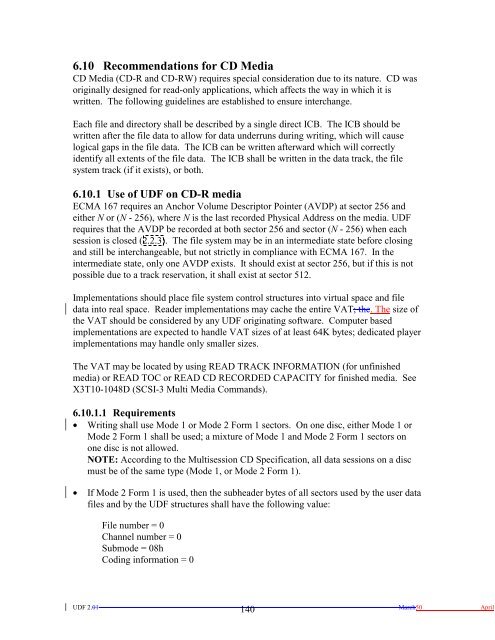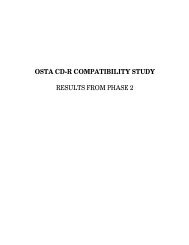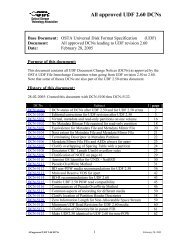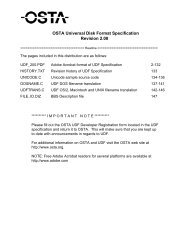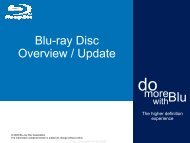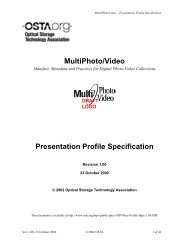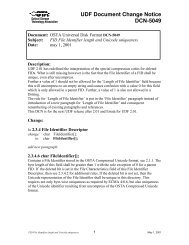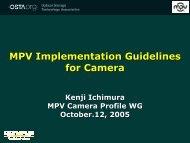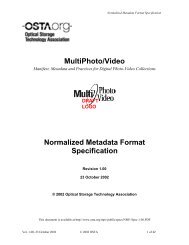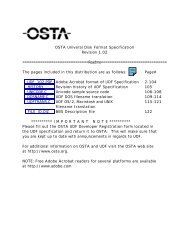here - OSTA - Optical Storage Technology Association
here - OSTA - Optical Storage Technology Association
here - OSTA - Optical Storage Technology Association
You also want an ePaper? Increase the reach of your titles
YUMPU automatically turns print PDFs into web optimized ePapers that Google loves.
6.10 Recommendations for CD Media<br />
CD Media (CD-R and CD-RW) requires special consideration due to its nature. CD was<br />
originally designed for read-only applications, which affects the way in which it is<br />
written. The following guidelines are established to ensure interchange.<br />
Each file and directory shall be described by a single direct ICB. The ICB should be<br />
written after the file data to allow for data underruns during writing, which will cause<br />
logical gaps in the file data. The ICB can be written afterward which will correctly<br />
identify all extents of the file data. The ICB shall be written in the data track, the file<br />
system track (if it exists), or both.<br />
6.10.1 Use of UDF on CD-R media<br />
ECMA 167 requires an Anchor Volume Descriptor Pointer (AVDP) at sector 256 and<br />
either N or (N - 256), w<strong>here</strong> N is the last recorded Physical Address on the media. UDF<br />
requires that the AVDP be recorded at both sector 256 and sector (N - 256) when each<br />
session is closed (2.2.3). The file system may be in an intermediate state before closing<br />
and still be interchangeable, but not strictly in compliance with ECMA 167. In the<br />
intermediate state, only one AVDP exists. It should exist at sector 256, but if this is not<br />
possible due to a track reservation, it shall exist at sector 512.<br />
Implementations should place file system control structures into virtual space and file<br />
data into real space. Reader implementations may cache the entire VAT; the. The size of<br />
the VAT should be considered by any UDF originating software. Computer based<br />
implementations are expected to handle VAT sizes of at least 64K bytes; dedicated player<br />
implementations may handle only smaller sizes.<br />
The VAT may be located by using READ TRACK INFORMATION (for unfinished<br />
media) or READ TOC or READ CD RECORDED CAPACITY for finished media. See<br />
X3T10-1048D (SCSI-3 Multi Media Commands).<br />
6.10.1.1 Requirements<br />
• Writing shall use Mode 1 or Mode 2 Form 1 sectors. On one disc, either Mode 1 or<br />
Mode 2 Form 1 shall be used; a mixture of Mode 1 and Mode 2 Form 1 sectors on<br />
one disc is not allowed.<br />
NOTE: According to the Multisession CD Specification, all data sessions on a disc<br />
must be of the same type (Mode 1, or Mode 2 Form 1).<br />
• If Mode 2 Form 1 is used, then the subheader bytes of all sectors used by the user data<br />
files and by the UDF structures shall have the following value:<br />
File number = 0<br />
Channel number = 0<br />
Submode = 08h<br />
Coding information = 0<br />
UDF 2.01<br />
140<br />
March50 April


